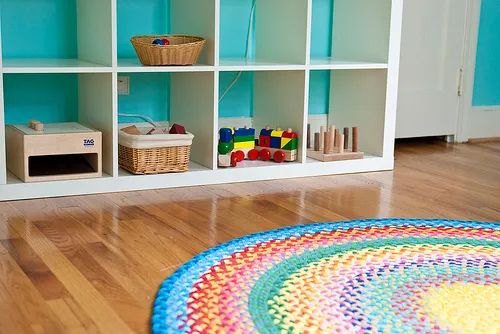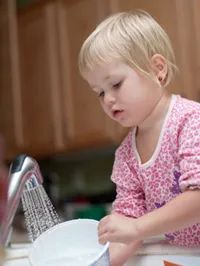The Ten Secrets of Montessori - #6 The Prepared Environment
"The first aim of the prepared environment is, as far as it is possible, to render the growing child independent of the adult." -Maria Montessori
Maria Montessori uncovered secrets--ten to be exact. Lucky for us, Mary Ellen Maunz, M. Ed., founder and Program Director of Age of Montessori, is willing to share the treasure of information within these secrets, and to explain exactly what they can mean to you and your children. With these ten secrets, you will gain a rich understanding of the framework beneath the Montessori Method. Maria Montessori developed more than a revolutionary educational method; she discovered the true inner workings of the child’s mind. These ten secrets are based on her lifetime of observing children and recognizing what they really need to thrive.

Secret #6: The Prepared Environment
One of the fundamental principles of the Montessori Method is the careful preparation of the child’s environment.

One of the fundamental principles of the Montessori Method is the careful preparation of the child’s environment. Put simply, this means that the child should have access to the right tools, at the right time. As Maria Montessori explained, "What is most characteristic of our system of education is the emphasis that is placed upon the environment." Of course, this can only be accomplished by understanding the child’s developmental needs, and knowing which materials or activities meet which developmental needs.
Montessori classrooms are designed to offer lessons, activities, and tools that match the developmental needs and interests of each individual child. It is important to note that not every child will be interested in every available lesson. This is why children are allowed to choose the lessons they gravitate toward naturally.
Obstacles must be reduced to a minimum and the surroundings should provide the necessary means for the exercise of those activities which develop a child's energies. ~Maria Montessori
The role of the teacher is to observe each child’s interests and his/her progress through the lesson. Teachers provide direction and/or assistance when needed to help the child connect with the learning materials. Based on this interaction with the children, teachers can swap out materials or introduce new ones.
There is only one basis for observation: the children must be free to express themselves and thus reveal those needs and attitudes which would otherwise be hidden or repressed in an environment that did not allow them to act spontaneously. ~Maria Montessori
The lessons and learning materials in the prepared environment are set out on low, easily accessible shelves.
The lessons and learning materials in the prepared environment are set out on low, easily accessible shelves. In addition to child-height shelves, Montessori classrooms have child-sized furniture, fixtures, tools, and utensils. By keeping the environment child-sized and accessible, the Montessori classroom minimizes the child’s need for adult assistance and maximizes the self-regulated activity.
When we speak of 'environment' we include the sum total of objects which a child can freely choose and use as he pleases, that is to say, according to his needs and tendencies. A teacher simply assists him at the beginning to get his bearings among so many different things and teaches him the precise use of them, that is to say, she introduces him to the ordered and active life of the environment. But then she leaves him free in the choice and execution of his work. ~Maria Montessori
The materials we see in Montessori-prepared environments, and this includes both school and home classrooms, have been developed through years of observation and experience, going all the way back to Maria Montessori herself. They are the same materials used all over the world and year after year because they are specifically designed to meet the developmental needs of each individual child, at every age and stage. Children choose the lesson or activity that perfectly matches with the sensitive period he or she is currently experiencing. (For a recap on Sensitive Periods, click here.)
True Montessori materials are presented to the child in the Four Avenues of Learning: Practical Life, Sensorial, Language and Mathematics.
Practical Life Materials

Practical life materials are real, everyday tools, often scaled down for little hands and statures. They teach real-life skills such as sweeping, pouring, washing dishes, setting a table, or dressing. Children will instinctively imitate the everyday activities they see around them. Through practical life lessons, children develop small and large motor skills, balance, hand-eye coordination, problem solving, independence, confidence, and more.
Sensorial Materials
As the name indicates, sensorial materials are designed to help children learn through their senses. Study after study have shown that sensory learning is the very foundation of early brain development. Starting from birth, children need an abundance of sensory information to build the neurological connections that are essential to human intelligence. Montessori’s sensorial materials provide active, hands-on experience for the senses.
Language and Math Materials
Both practical life and sensorial activities help build the neurological infrastructure necessary for learning language, math, science, and more. The area of language development starts with early mastery of the spoken word and moves on to the learning the individual sounds of spoken language, followed by learning the letters as symbols of those sounds; then word building and the broadening of vocabulary. These skills open the door to reading, writing, and grammar skills. Classic Montessori materials for language development include sand paper letters, phonics cards, and movable alphabets. If you’d like to learn more about how you can teach your child to read at home, check out the Royal Road to Reading DVD system for parents, homeschoolers, and teachers.

The Montessori Method also uses hands-on materials to teach math and science. Through materials such as the classic golden beads, number rods, and spindle boxes, children learn the basics of mathematical and scientific concepts. These concepts, in turn, prepare the child for more advanced lessons.
For information on how parents can reap the many rewards of the Montessori-prepared environment at home, please follow this link. Or learn more about the prepared environment in this free, online Age of Montessori webinar: Montessori in the Home.
Webinar replay:
You will learn how to:
- Increase harmony in your home
- Nurture children’s love of order and keep your home neater
- Better meet the needs of your children’s developmental stages
- Prepare the environment to satisfy children’s sensitive periods
- Crack the code of communication hidden behind “misbehavior”
- Engage your children effectively while growing their brains and self-esteem!
Presenters:
Jennifer Williams, Founder of Heartmanity
Nancy McNabb, Middlecreek Montessori School Director






















